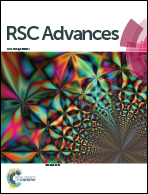Effects of nitrogen-dopants on Ru-supported catalysts for acetylene hydrochlorination†
Abstract
A series of N-doped spherical active carbons were synthesized via the pyrolysis of melamine in activated carbon, and used as a support to prepare Ru-based catalysts for an acetylene hydrochlorination reaction. The catalytic performance assessments indicate that the N-doped carbon support can increase greatly the activity and the stability of Ru-based catalysts. The optimal activity is achieved over Ru/SAC-N700, with an acetylene conversion of 99.8% under the conditions of 170 °C, C2H2 gas hour space velocity (GHSV) of 180 h−1, a feed volume ratio of V(HCl)/V(C2H2) of 1.1 after 30 h. Using characterizations of BET, FT-IR, XPS, TPR, TPD, TG, etc., it is illustrated that N-dopants can increase the dispersion of Ru elements, enhance the adsorption of reactants and the desorption of the product, and reduce significantly the coke deposition, consequently resulting in higher catalytic activity of Ru/SAC-N700. It is suggested that the pyridine–nitrogen plays an important role in augmenting the catalytic activity of Ru-supported catalysts.


 Please wait while we load your content...
Please wait while we load your content...